

CARCANO ARISAKA TYPE I
Article written by Bondino,
updated by
F. A. Mancuso
It is an interesting piece that at first glance seems a 91 rifle (the long one) with the two-pieces Japanese-like buttstosck.

In 1938, Japan is engaged in the war against China. The alliance between Japan, Italy and Germany has not yet been established (it will be in 1940) but since 1936 Japan and Germany have signed the anti-Comintern agreemnt, signed by Italy one year later: the Axis Tripartite is emerging, and Tokyo and Berlin start a significant industrial effort to be ready for the wars to come.
In this political and military situation, Japanese government issue an order for 60,000 Italian Carcano rifle long adapted to the size of the standard Japanese cartridge: the 6.5 mm Arisaka.
The whole of the original blueprints of the Carcano Arisaka were made at Fabbrica d’Armi of Terni but it is logical to assume that they were based upon Japanese requirements. At Terni, they did not realize the rifles, but they assigned instead the Sezione Fabbrica d’Armi Regio Esercito (SFARE) at Gardone Val Trompia to produce 30,000 pieces, while the other 30,000 pieces were contracted out to civil firms: Beretta at Gardone V.T. and the Fabbrica Nazionale d’Armi (FNA) of Brescia. The numbers are very approximate because the documents were lost, production and allocations between the three factories are only hypotheses, among other things is not even known whether the total amount of weapons has actually been achieved.
Each time a batch was ready, was sent to the SFARE for acceptance by a commission of Japanese officers.
Production began at the end of '38 and ended in mid '39, the weapons were supplied with all the mechanical parts but without belts and bayonets and the wooden stocks were not finished with protective coatings, as Japanese choose to take care of this.
There are almost no markings on the rifle, except for the serial number. It is to note that also the classical chrysanthemum is missing, may be it would have been impressed by a Japanese arsenal.

Only the long rifle was in the scope of the agreement: no short rifle or carbine of Arisaka Carcano model are known.
It is known that Beretta realized an interesting prototype using the Mauser magazine instead of the Mannlicher system and based upon the short rifle model 38, chambered for the 7.35x51 cartridge. If approved by the Italian Army, it would have caused even more logistical problems.
The Arisaka Carcano utilizes the same receiver, bolt, cocking piece, striker, safety/bolt sleeve, trigger, extractor and ejector of Italian 91, however, the bolts are not interchangeable because the groove cut on the bodies of the two bolts for the passage of the ejector are not in the same position (in the first of the two pictures below, the Carcano Arisaka bolt is on the right).
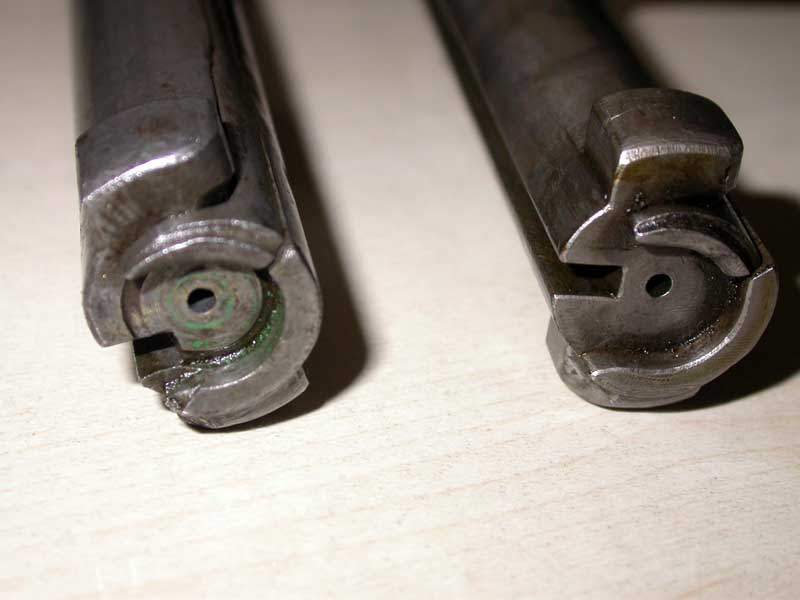

The upper part of the receiver has milled groove to allow the utilization of the Mauser stripper clip. Those clips are scarce today, but they should be not so different from the standard clip, as they should be large enough to keep the rim of the 6.5 mm Arisaka cartrdige, that has a semi-rimmed case.
The Mauser magazine box is similar to the same magazine as utilized by the Arisaka 1905 (or model 38, since 1905 the 38-th year of the reign of Emperor Meiji), the finest of the Japanese military bolt action rifle.
The Carcano Arisaka can be unloaded as the model 1905 (38): just depress the latch located into the front part of the trigger guard, this releases the floorplate of the magazine box.


The rear sight (an adjustable leaf, plus a fixed battle sight, both with a wide V-notch), is the same of the Arisaka "38".
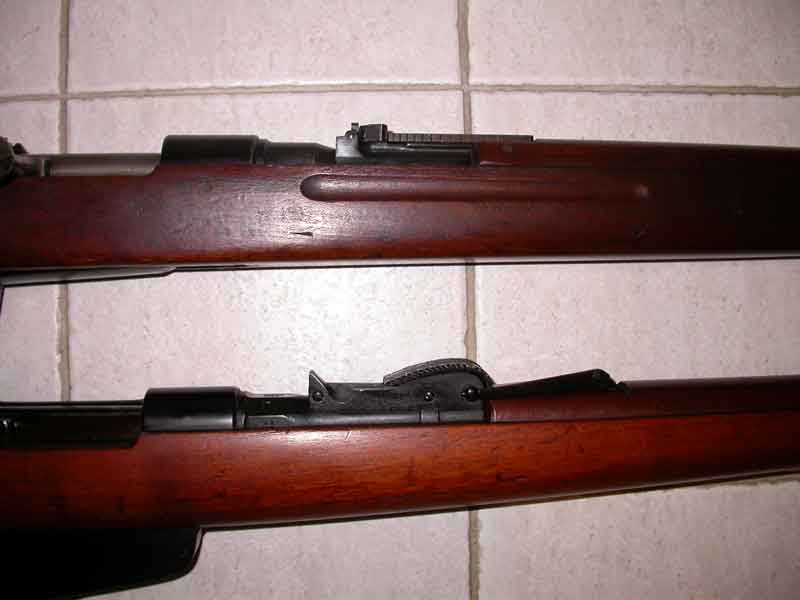

The front sight is quite different from the sight of Japanese Model 1905 (38), and it is not protected by ears.

The rifle was issued with the same cleaning rod of the model 1905 (38): too bad it is missing here.

The barrel Carcano Arisaka is 2 cm shorter than the 1905 (38). It has a progressive rifling with four grooves of the Metford type, and this gave rise to manufacturing problems, but, once the process was fine tuned, accuracy and muzzle velocity exceeded the requirements.
Type I buttstock is very similar to Arisaka 1905 (38) buttstock, with the lower part dovetailed and glued to the rest of the stock. The reason for this assembly is controversial, it is normally considered a method to save timber. Personally I think it is to give greater stability to the butt of weapons intended for use in hot and humid climates such as the jungle.

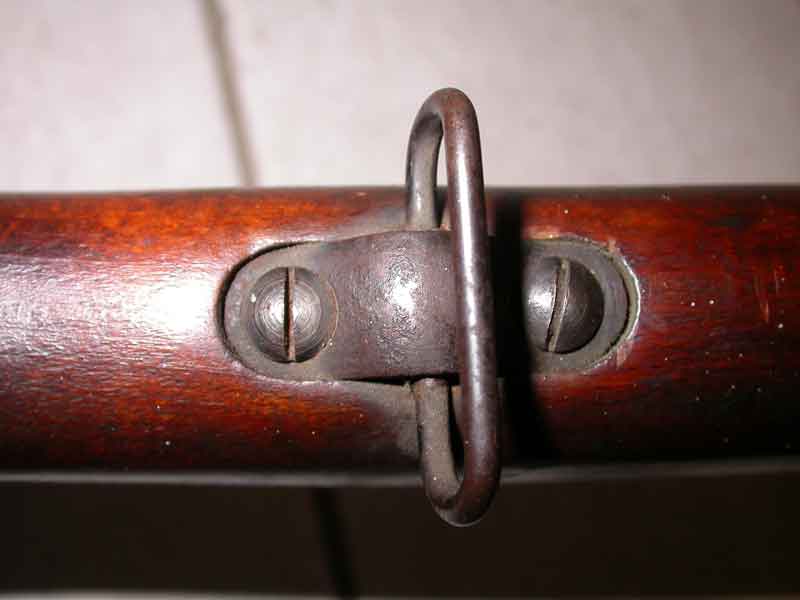
Unfortunately I was not able to find evidences of the actual utilization of these guns during the war: whoever can tell me more is kindly asked to do so.
I have not yet shot this weapon, as I would like to load a cartridge that is similar to the original one, but I was able to find SP commercial bullet only, and not FMJ.
----
Update - May, June and September 2010
What follows is material kindly provided by Dr. Ugo Venturoli, and was originally intended to be published with an article which appeared in the American press in 1970, specifically on "American Rifleman" magazine. [1]
Here below, a reproduction, so far unpublished, of an original picture of the weapon, which illustrates a cross-section and a plan view. By clicking here, or on the picture, you can bring up a picture of higher resolution.
It is clear that the two components of the buttstock are kept toghether in a more complex way than the exterior appearance of the weapon suggest.
Then, there are electronic reproductions of two photographs [2] that depict members of the committee in charge of weapons testing at the factories in Italy.
The caption under the first picture (the only one that has been published, until now) reads: "Somewhere in Gardone Japanese officers in 1939. The place can be the proofhouse or the arsenal either. Note the white uniforms: are they from the Navy? ".
If it were up to me, knowing nothing about uniform, doubt is bound to remain so. But, thanks to The Net, someone who has a knowledge on uniforms way deeper than mine was able to take a look at the picture and identify which force belonged to the two officers with the white uniforms that appear in the center of the photo: you can find his contribution by clicking here, (thank you, Furiere Maggiore!).
At the end of this page, a second picture, published here for the first time, in which the poses taken, if not less spontaneous, are certainly more formal. The setting is the same, but the window on the right of the photo is now closed, the subject in the center of the photo is a different guest from Japan that does not wear a uniform, among Italians faces there are only a few that are similar with those in the picture above, and among those one seems to have different decorations between the two photos.
Two pictures to record two different events? Or two pictures taken in a short time, with different actors?
Each of these two pictures can be seen enlarged by clicking on the image.
The contribution of other collectors is not finished here.
Dr. Fabio Sacco, an Italian collector and a lawyer, sent me some pictures of his Type I rifle (that is very good condition), put side by side with another Type I (marked PB on the root of the bolt handle) that belongs to Vincenzo Fortunati (author of the book "La Mauser 1899 e la Regia Marina Italiana").
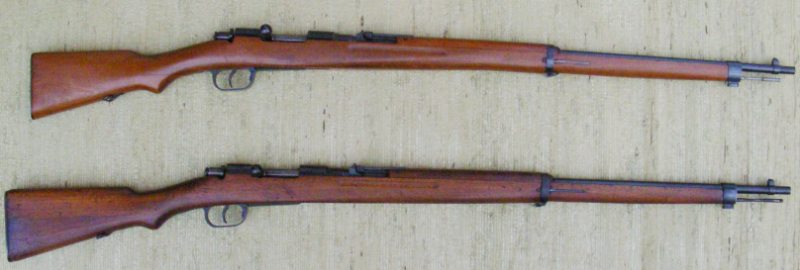
Fabio Sacco's weapon has a buttstock shorter than those of Vincenzo Fortunati and Bondino.

The difference is best seen observing an enlarged picture, such as those here below.

The distance between the centreline of the buttplate and the front of the trigger is about 33 cm for the shorter rifle (that equals the measurement I took on my Arisaka 38) and it is close to the length that I found on a Carcano 91/41.

The same distance is at least 36.5 cm on the longer weapon (on a Carcano 1891 it
is 35.5 cm).
The “short”
buttplate is similar but not identical to the "long" one (10.8 cm vs. 12.0
cm), and the screw holes are closer to each other.
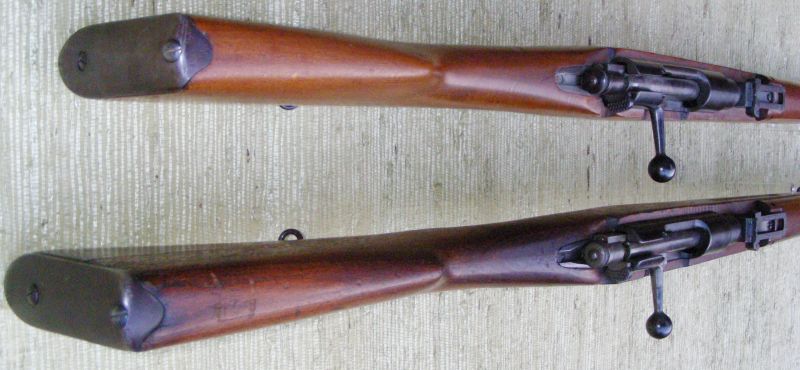
This feature, combined with the presence of a rib along its perimeter, where the metal matches the wood, says that the smaller buttplate was not obtained by modifying a larger one.
Even this weapon has no marks, apart from the serial number (E1920, this one on the receiver box) and, of course, the modern proofhouse markings.
The root of the bolt handle bears the mark stamped "45" inscribed in a rhombus (which leads to the production of Gardone Val Trompia, FAG).
The short buttstock was undoubtedly the most suitable to the average height of Japanese soldier: how to explain the longer one?
In their recent books, Pettinelli and Di Giorgio simply say that "there were stocks of different lengths", while Riepe does not mention it at all.
A wrong assessment of the designer, who used to size the stocks on the height of the average Italian soldier, and a change after the start of production?
Two parallel productions, with different destinations in mind?
I cannot answer the questions.
Here below the contribution of a collector from U.S., Roy McLeod, we were able to get in touch thank to www.surplusrifle.com and its forum.
The first rifle from the top does not have any finishing. The finishing of the second one is the typical military finishing of similar rifle. The finishing of the third rifle has been restored. The sporterized Type I chambers the 257 Roberts, and the Mauser-type magazine should have been of a significant help to the efficiency of the weapon.
Richard Hobbs says that he first saw Type I while scrounging around Interarms (the firm of the legendary Samuel Cummings): they just opened a case of rifles ad inside were new Type I's, with unoiled, white stocks.
Is this rifle one of those, unfinished, seen by Richard Hobbs?
What is clear is that the finishing of this rifle seems to be even less sophisticated than the most simple finishing applied to Italian weapons (i.e. the stock was submerged into hot lineseed oil, than let to dry, and plunged another time into the oil), as the dark wood of the handle tell us.
[1] Dr. Venturoli has kindly provided to me a scan of his aforementioned article published in American Rifleman in 1971, it is available by clicking on the link below, in the bibliography.
[2] They were literally retrieved in extreme conditions.
Furthermore, as in 1970 the original negatives were missing, and scanners were
not so readily available
![]() , Dr.
Venturoli had to take a picture of the photographs,
to make new negatives for further printings.
, Dr.
Venturoli had to take a picture of the photographs,
to make new negatives for further printings.
Bibliography
§ U. Venturoli - Type I not "Made in Japan" - American Rifleman, Vol. 119, No. 12, Dicembre 1971
§ R. J. Hobbs - The Carcano Italy's Military Rifle - R. J. Hobbs, 1997